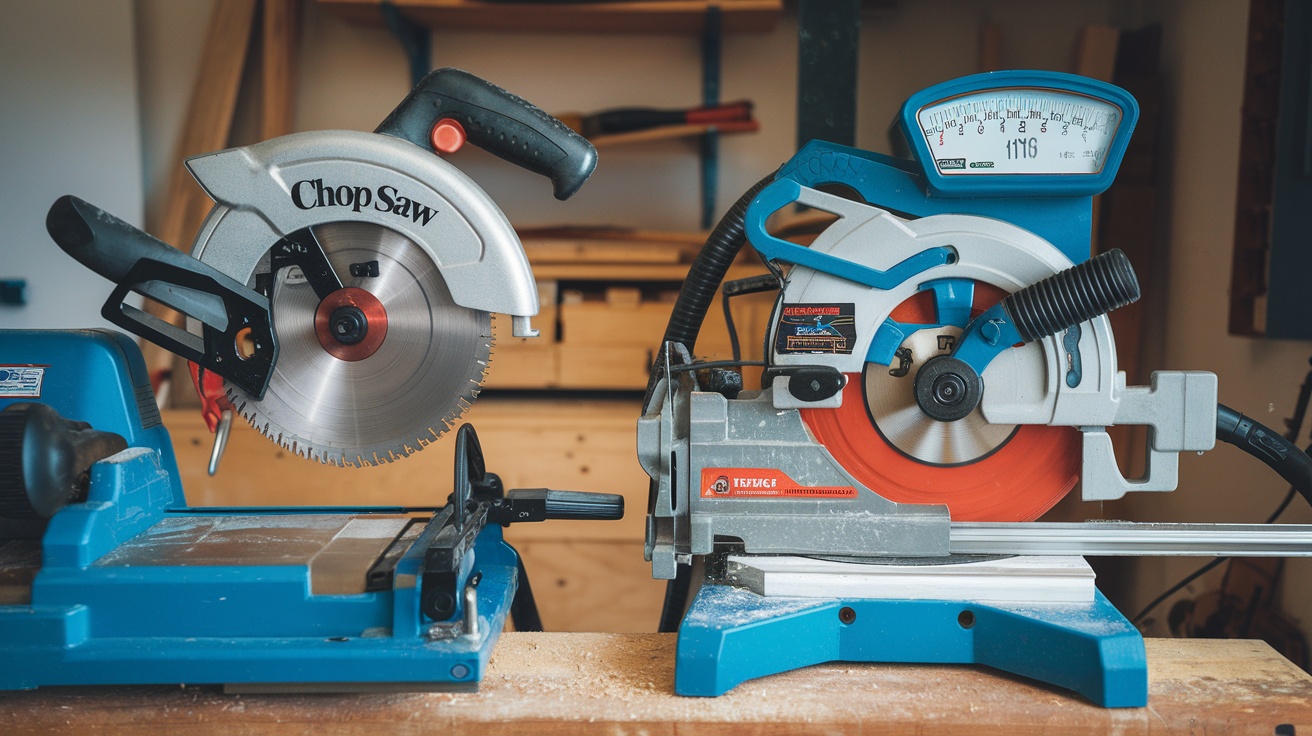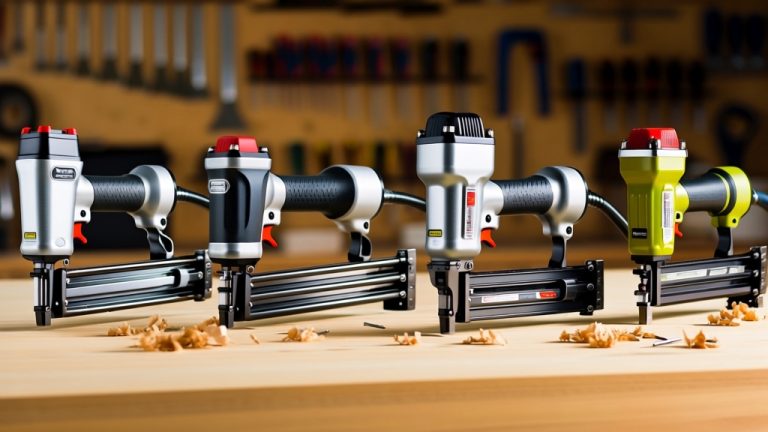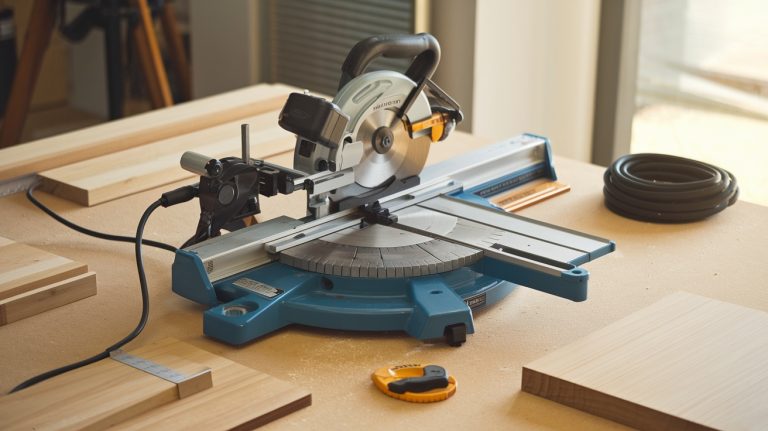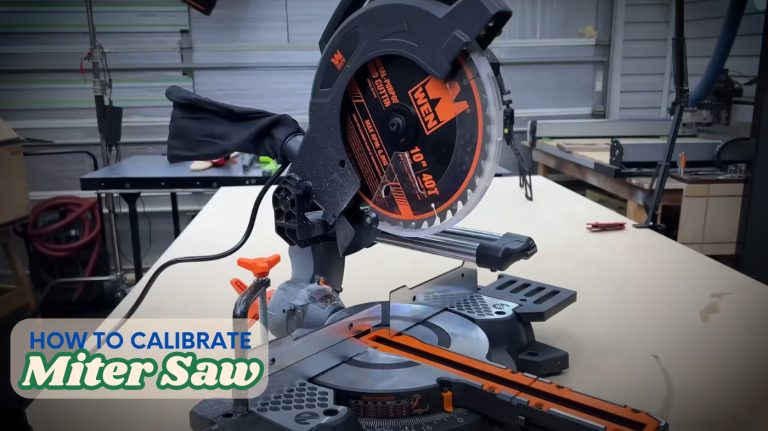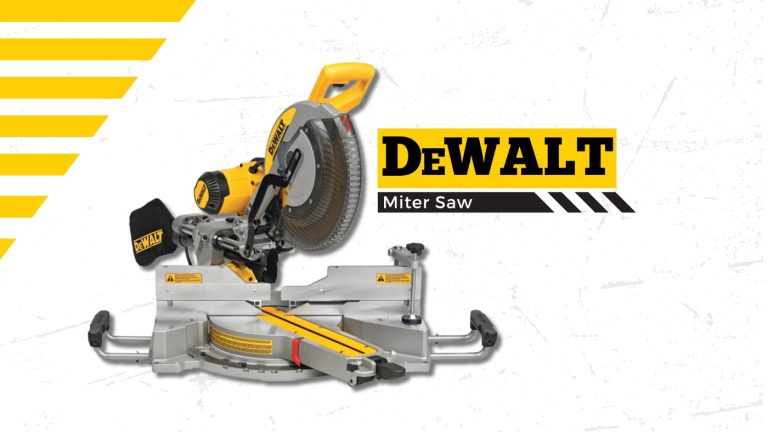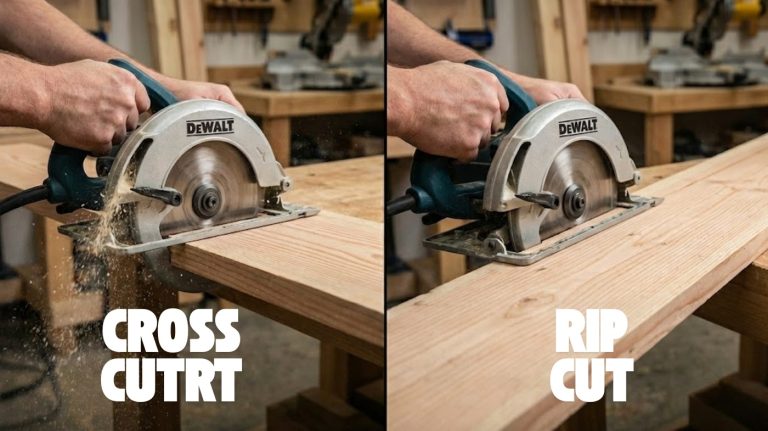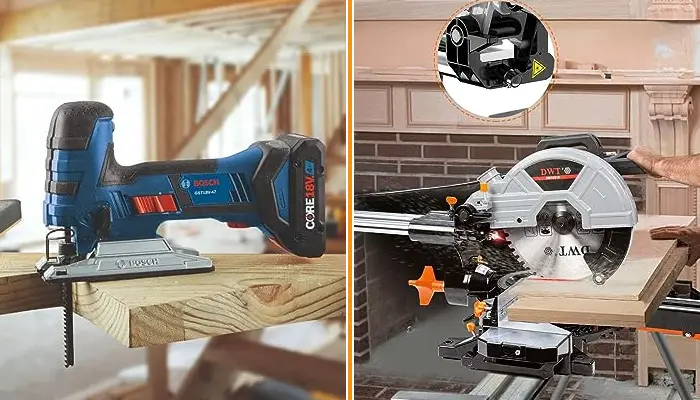Is a Chop Saw the Same as a Miter Saw? Key Differences
No, a chop saw isn’t the same as a miter saw. Chop saws are designed for heavy-duty cuts, typically at a straight 90-degree angle, ideal for metal and tough materials.
They operate with abrasive blades and are excellent for high-volume tasks. In contrast, miter saws excel in fine woodworking, allowing for angled and bevel cuts due to their pivoting table and tilting head.
They use carbide-tipped blades for precision in cuts like miter and compound angles. Understanding these differences will help you choose the right tool for your project, and there’s more to explore on this topic.
- Powerful 15 amp/5.5 HP (maximum motor HP) motor provides more overload capacity, increasing…
- Quik-change keyless blade change system increases productivity by providing the user the ability to…
- Exclusive QUICK-FENCE is a 45-degree, adjustable fence designed for fast and accurate angle cuts…
- POWERFUL AND PRECISE: This 10-inch compound miter saw features a 15-Amp motor delivering high power…
- USER-FRIENDLY DESIGN: The miter saw includes thumb-actuated positive stops for quick miter…
- LIGHTWEIGHT AND PORTABLE: Weighing only 24.2 lbs, this power saw is easy to maneuver and transport…
Key Takeaways
- Chop saws are designed for heavy-duty applications, primarily cutting metal and tough materials, while miter saws excel in fine woodworking tasks.
- Miter saws can make angled and bevel cuts due to their pivoting tables, unlike chop saws, which are limited to straight cuts at 90 degrees.
- Chop saws typically use abrasive blades, whereas miter saws utilize carbide-tipped blades optimized for wood and wood-based materials.
- The size and power specifications differ: chop saws usually have larger blades (14 inches) and higher power (2300 watts) compared to miter saws.
- Each saw has distinct usage scenarios; chop saws are common in welding and construction, while miter saws are preferred for cabinetry and trim work.
Main Differences Between Chop Saw and Miter Saw
While both chop saws and miter saws are essential tools in woodworking and construction, they serve distinct purposes that cater to different needs.
Chop saws are primarily designed for heavy-duty applications, making them ideal for cutting metal and tough materials.
Their robust power and larger blades—often up to 15 inches—allow for quick, straight cuts at 90 degrees. This tool is particularly effective for producing burr-free cuts in various metals, ensuring a clean finish.
In contrast, miter saws excel in fine woodworking, offering versatility with angled and bevel cuts. They typically feature smaller, carbide-tipped blades, up to 12 inches, enabling precise work on wood trim and molding.
The design differences are vital. Miter saws come with features like tilting heads and pivoting tables, enhancing their adaptability for various cutting angles.
Meanwhile, chop saws focus on straight cuts without such versatility. When considering material compatibility, chop saws handle thicker, tougher materials, while miter saws are tailored for finer, detailed tasks.
Understanding Chop Saw Features
Chop saws are powerful tools designed for specific cutting tasks, making them an essential asset in workshops and construction sites.
With a large blade size, typically around 14 inches, these saws are equipped with high-power motors that enable them to cut through thick materials like steel plate and angle iron.
You operate a chop saw by lowering the spinning blade onto the material placed on a fixed base, using a pivoting arm, which guarantees precision and control. Additionally, chop saws are optimized for heavy-duty metal cutting, ensuring they perform efficiently in demanding environments.
Safety features are paramount. A blade guard protects you from flying debris, while a vice or clamp secures the material being cut, preventing movement during operation.
For clear sightlines and safety, many models include a spark deflector. The spindle lock feature allows for easy blade changes, and the heavy-duty steel base provides stability during cutting.
Chop saws specialize in making straight cuts, limiting you to 90-degree angles. They excel in high-volume tasks in construction and fabrication settings, handling various materials, including metal, wood, and composites.
Chop saws are particularly effective for cutting through materials with embedded nails, making them versatile for various applications.
Exploring Miter Saw Features
When you choose a miter saw, you’ll appreciate its precision cutting capabilities, allowing you to make exact angled cuts for various projects.
Additionally, these saws can utilize specific blade designs to optimize cuts for different materials, enhancing their versatility. You’ll also notice the blade size variations, which determine the cutting capacity suited for your specific needs.
With versatile cutting angles, these saws provide the flexibility to tackle everything from simple crosscuts to complex compound angles. Moreover, understanding the cutting capacity of the saw will help you select the right tool for your project requirements.
Precision Cutting Capabilities
A miter saw excels in precision cutting, making it an essential tool for any woodworking project. With built-in detents for common angles like 0°, 22.5°, and 33.9°, you can quickly achieve precise miter cuts. The locking mechanisms allow you to set and maintain these angles with confidence, ensuring repeatable cuts that meet your specifications.
Features such as laser guides or LED light-assisted shadow lines enhance accuracy, allowing you to visualize your cut line clearly. Additionally, modern models often offer improved accuracy through crisp detents and smooth motor carriages, which significantly contributes to achieving precise results with every cut.
Adjustable miter gauges provide further customization, giving you the flexibility to make complex bevel cuts and compound miter adjustments. Quick-release mechanisms facilitate fast angle changes, which saves you time during your project.
Miter saws are versatile, capable of making straight, miter, and bevel cuts across various materials, making them ideal for trim work, framing, and molding. They can even crosscut larger lumber like 2×12 or 4×4 in a single pass, demonstrating their cutting capabilities.
Additionally, the controlled movements and stability of a miter saw make it accessible for users with limited mobility, ensuring everyone can achieve precision in their woodworking tasks.
Blade Size Variations
Understanding blade size variations is essential for maximizing the performance of your miter saw. Blade sizes typically range from 7 1/4 inches to 12 inches, with each size catering to specific tasks.
For smaller projects, a 7 1/4-inch blade is adequate, while a 10-inch blade strikes a balance between cutting capacity and speed.
If you’re tackling heavy-duty work, a 12-inch blade offers the largest cutting capacity, ideal for professional-grade applications.
Additionally, consider the kerf thickness, which impacts cutting efficiency. Thin-kerf blades, measuring about 3/32 inch, remove less material and create less resistance, making cuts easier, though they may deflect under heavy loads.
In contrast, full-kerf blades have a cutting width of about 1/8 inch, providing stability but requiring more power. Full-kerf blades are preferred for stability and quality of cut, especially when working with denser materials.
Moreover, using a cordless miter saw can enhance mobility and ease of use, particularly when working in various locations.
Be certain to choose the right arbor size for your saw—common sizes include 5/8 inch for standard miter saws and 1 inch for 12-inch blades.
Always opt for high-quality carbide teeth and consider blade designs like Ultra-Shear or High-angle ATB for specific applications. This thoughtful selection ensures your miter saw performs at its best, delivering precision cuts for your projects.
Versatile Cutting Angles
Choosing the right blade size can greatly enhance your cutting capabilities, but the versatility of a miter saw truly shines through its adjustable cutting angles. With a maximum miter angle that offers flexibility, you can tackle a variety of projects with ease.
For example, miter cuts are essential for trim work, while bevel cuts, achievable by tilting the saw head, allow you to create angled cuts through the thickness of the material.
The ability to make precise miter cuts improves the overall quality of your woodworking projects. Additionally, both the Metabo HPT and Virutex models offer positive stops that enhance accuracy.
Compound miter saws add even more functionality by enabling you to pivot and tilt for both miter and bevel cuts. This feature is especially valuable for complex projects requiring precise compound angles.
Additionally, sliding miter saws extend the cutting range without increasing cutting depth, giving you versatility in larger pieces.
Miter saws often include built-in stops at common angles like 45 degrees, ensuring accuracy and saving you time.
Whether you’re working on cabinetry, framing, or DIY projects, these adjustable cutting angles make miter saws indispensable tools for achieving the precision you need. In contrast, chop saws lack this versatility, limiting you to straight cuts without the ability to create angled or bevel cuts.
Common Misconceptions Clarified
When choosing between a chop saw and a miter saw, it’s essential to understand their distinct functions and capabilities.
Chop saws excel in cutting tough materials like metal with straightforward, 90-degree cuts, while miter saws offer versatility for various angles, making them ideal for woodworking.
Additionally, blade types vary significantly between the two, with chop saws using abrasive blades and miter saws utilizing carbide-tipped blades.
Tool Function Differences
In the domain of power tools, distinguishing between a chop saw and a miter saw is essential for achieving ideal results in your projects.
A chop saw typically employs abrasive cutting wheels and is designed for making straight, 90-degree cuts in tough materials like metal. It usually features larger blades, around 14 inches, making it suitable for heavy-duty work.
On the other hand, a miter saw uses circular saw blades with teeth, ranging from 10 to 12 inches, and excels at making precise angled cuts. This tool is essential for precise cuts at various angles, which is critical for achieving accuracy and efficiency in woodworking tasks.
Sliding miter saws, in particular, enhance versatility with their ability to cut larger materials due to their greater cutting capacity.
While chop saws are fixed to 90-degree cuts, miter saws offer versatility with the ability to make miter, bevel, and compound cuts at various angles. This makes miter saws the go-to tool for woodworking and fine applications.
Moreover, chop saws are built for robust construction tasks, while miter saws prioritize precision and ergonomic features. Each tool serves distinct purposes; using one in place of the other can result in suboptimal outcomes.
Material Suitability Explained
It’s essential to recognize that chop saws and miter saws serve distinct purposes based on the materials they’re designed to cut.
- Chop saws excel in cutting metal rods, pipes, and wood with embedded nails.
- Miter saws specialize in making precise cuts in wood and wood-based materials. Additionally, precision cutting is crucial for achieving professional-grade results in woodworking.
- Abrasive wheels in chop saws are ideal for metal, while carbide-tipped blades in miter saws are tailored for wood.
- Using the right tool for the job enhances efficiency and safety. Mitre saws are particularly effective for intricate trim work, such as cabinetry and molding.
Many users mistakenly believe these saws can handle any material interchangeably. This misconception can lead to ineffective cuts and potential safety hazards.
Miter saws lack the capability to efficiently cut metal, as they’re primarily designed for woodworking tasks.
Cutting Techniques Variability
Cutting techniques between chop saws and miter saws often lead to confusion, especially among those new to woodworking or metalworking.
Chop saws are primarily designed for making straight cuts at 90 degrees, using abrasive blades suitable for metal. In contrast, miter saws excel in versatility, allowing for straight, miter, and bevel cuts at various angles thanks to their pivoting tables and tilting heads.
Additionally, miter saws are favored for woodworkers because they can handle various sizes, from small stock to boards over a foot wide. This versatility makes miter saws especially effective for cross cuts in woodworking applications.
When you need precise angle cuts, miter saws are your go-to. They utilize carbide-tipped blades for accuracy, making them ideal for fine woodworking projects.
On the other hand, chop saws focus on delivering high-precision straight cuts, particularly in metalworking applications.
Consider the cutting capacities as well; chop saws typically handle shorter metal pieces with blades up to 15 inches, while miter saws cut wood using blades up to 12 inches.
Typical Usage Scenarios
While both chop saws and miter saws serve essential functions in woodworking and metalworking, their typical usage scenarios differ considerably due to their design and intended materials.
Chop saws excel in cutting metal, making them a staple in various industrial settings. You’ll typically find them in:
- Weld shops, where precise metal cutting is vital.
- Fabrication shops, relying on them for accuracy with steel and aluminum.
- Maintenance shops, performing repetitive metal cuts efficiently.
- Construction projects, particularly when metal components are involved.
On the other hand, miter saws are your go-to tools for woodworking tasks. They allow for intricate cuts in wood, essential for projects like trim work and cabinetry.
Miter saws are particularly well-suited for making crosscuts and miter cuts, which are crucial for achieving clean joints in woodworking.
You’d primarily use miter saws for:
- Woodworking projects, where precision is key.
- Framing and molding, ensuring clean and accurate angles.
- DIY projects, enabling you to create custom designs.
- Construction and renovation, focusing on wooden structures.
Technical Specifications Overview
When selecting the right tool for your projects, it’s important to contemplate the technical specifications that differentiate chop saws from miter saws.
Chop saws typically feature a larger disc diameter of 14 inches, whereas miter saws range from 8 to 12 inches. The power output also varies, with chop saws delivering around 2300 watts at 15 amps, while miter saws operate between 10 to 15 amps.
Additionally, chop saws are designed for heavy-duty applications, making them suitable for various materials beyond just wood. This versatility allows chop saws to handle substantial wood pieces effectively.
In terms of cutting capacity, chop saws can cut materials up to 5 inches thick, making them suitable for metal work, while miter saws are primarily designed for wood and their capacity varies depending on size.
The motor speed is another key difference; chop saws run at approximately 1450 rpm, while miter saws boast a much faster 8000 rpm, allowing for cleaner cuts.
Bevel capability is limited in chop saws to 45 degrees, while miter saws can adjust from 45 to 90 degrees.
Additionally, chop saws often lack advanced safety features like automatic shut-off and blade guards, which are standard in miter saws.
Choosing the Right Tool
Choosing the right tool for your project is essential to achieving the desired results efficiently and safely. When deciding between a chop saw and a miter saw, consider the specific requirements of your project.
- Material Type: If you’re cutting metal or thick materials, a chop saw is your best bet. For wood, go with a miter saw.
- Cut Precision: Miter saws excel at making precise angled cuts, ideal for trim work and cabinetry. This is particularly important since they specialize in precision cuts, ensuring accuracy for detailed projects. Miter saws provide a clean, precise cut that enhances the quality of finished work.
- Cut Types: Remember, miter saws can perform miter, bevel, and compound cuts, while chop saws are limited to straight cuts.
- Project Environment: Think about where you’ll use the tool; chop saws suit industrial settings, while miter saws fit well in home workshops.
Safety Considerations for Users
Safety considerations are essential for anyone using a chop saw or miter saw, guaranteeing both effective operation and personal protection. Follow these general safety precautions to minimize risks and enhance your work environment.
| Safety Aspect | Recommended Practice |
|---|---|
| Eye Protection | Wear industrial-quality safety glasses or a face shield. |
| Clothing | Avoid loose clothing and jewelry; secure long hair. |
| Hearing & Dust Safety | Use hearing protection and a dust mask. |
When operating the saw, always maintain a safe distance from the blade and inspect your materials for any defects. Never rush the cutting process, and ascertain you’re not making free-hand cuts.
Prior to use, inspect the saw and its components thoroughly, including checking the blade alignment and the electrical cord. Remember to wear appropriate safety gear to ensure your personal protection while operating the saw.
Utilize safety features like blade guards and electric brakes, and keep your workspace tidy by regularly clearing sawdust.
Frequently Asked Questions
Can Chop Saws Cut Wood Effectively?
Yes, chop saws can cut wood effectively.
They’re designed for accurate crosscuts and miter cuts, making them ideal for woodworking tasks. With larger blades and stable bases, you’ll achieve precise results, even on thick materials.
Their ability to handle repetitive cuts without errors enhances their efficiency. Whether you’re working on professional projects or DIY tasks, chop saws provide the accuracy and versatility you need for a variety of wood cutting applications.
Are Miter Saws Suitable for Cutting Metal?
Miter saws can cut metal like a hot knife through butter, but they aren’t your best bet for extensive metalwork.
With the right multi-material blade, you can achieve precise cuts in aluminum and mild steel.
However, keep in mind that they’re designed primarily for wood, and their limitations in blade size and cutting style mean that, for heavy metal tasks, a dedicated chop saw might be a better choice.
What Safety Equipment Is Recommended When Using These Saws?
When using chop saws or miter saws, always wear safety glasses, hearing protection, and fitted clothing.
For chop saws, consider safety shoes and a hard hat. Before use, inspect blades and verify proper installation.
While operating, keep your body away from the blade, maintain balance, and avoid pinching the blade.
For miter saws, check for hazards in the material and use clamps to secure your workpiece.
Prioritize safety at all times.
How Do I Maintain My Chop or Miter Saw?
To maintain your chop or miter saw, regularly clean off dust and debris after each use.
Inspect the blade for sharpness and damage, replacing it if necessary.
Lubricate moving parts according to the manufacturer’s instructions to guarantee smooth operation.
Check for wear and tear, particularly on the power cord and safety features.
Finally, store the saw in a dry place and cover it when not in use to prevent rust and corrosion.
What Is the Average Lifespan of These Tools?
So, you’re wondering how long your trusty saw’s gonna last?
Well, if you’re not cutting metal like it’s a birthday cake, you might be in luck!
On average, a chop saw can endure a few years, while a miter saw can last longer with proper care.
Factors like usage frequency and maintenance play a huge role.
Treat them well, and they might just outlive your latest DIY project!
Choose the Right Tool: Chop Saw vs. Miter Saw for Your Project
In conclusion, while chop saws and miter saws may seem similar, they serve distinct purposes and features that cater to different needs. For instance, if you’re framing a house and need precise angled cuts, a miter saw is your go-to tool.
Conversely, if you’re cutting through thick metal pipes for a plumbing job, a chop saw is what you need. Choosing the right tool enhances your project’s efficiency and accuracy, ensuring you get the job done right.
Last update on 2025-12-20 / Affiliate links / Images from Amazon Product Advertising API

